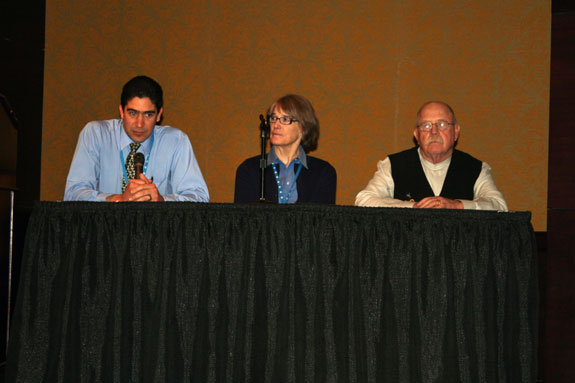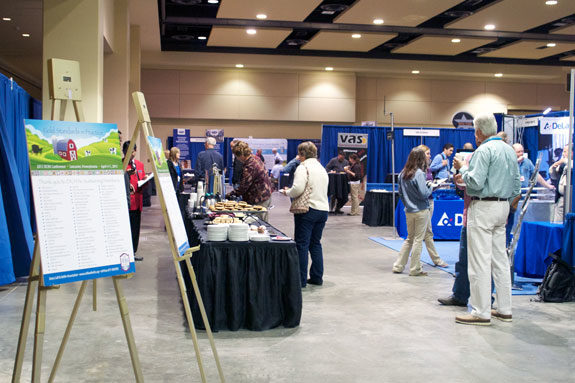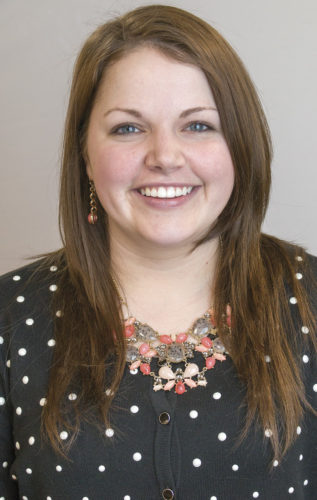About 250 calf raisers and company representatives attended the Dairy Calf & Heifer Conference, held April 4-5 in Lancaster, Pennsylvania.
The two-day conference featured several general sessions, a variety of breakout topics and an equipment demonstration.
Vita Plus Corporation's Gary Sipiorski kicked off the conference with a presentation about volatility in today's industry and where calf and heifer raisers can seize new opportunities.
Breakout sessions throughout the conference featured topics such as meeting energy needs of bred heifers, how to enhance neonatal immunity, new research in alternative proteins in milk replacers and advantage of 3X feeding in pre-weaned calves.
Dr. Sam Barringer's talk on the afternoon of April 4 kept attendees' attention when he compared raising calves to his own experiences of managing troops in the U.S. Air Force and Army.
He urged calf raisers to develop systems and processes customized to their operations but also ones that workers and second-in-command managers could easily follow.
"This is not a complex business," he said of the dairy industry. "It has a lot of moving parts, but it doesn't have to be complicated."
Barringer raised a few eyebrows when he talked about how colostrum may not be as much of a necessity as some claim.
"I'm saying that in spite of the importance of colostrum, we've figured out how to do without it," he said.
He encouraged attendees to maintain a focus on colostrum but to not get too caught up in the numbers.
Wisconsin Veterinary Diagnostic Laboratory's Dr. Donald Sockett reminded calf growers that a successful colostrum program can help prevent respiratory disease, along with proper bedding and ventilation.
He said that ideally, calves should be housed individually with at least 4 feet of isolation, but that even 1 foot would make a difference in preventing the spread of disease and proper air circulation.
When asked about group housing, Sockett said, "If managed properly, the benefits of group housing can outweigh the risks."
Sockett returned April 5 to kick off an equipment demonstration with Dr. Tom Earleywine of Land O'Lakes Animal Milk Product Company.
Earleywine described calf research conducted using the airIDEAL device, which has been primarily used to measure air quality in hospitals and cruise ships.
He referred to the equipment as an "$8,000 sledgehammer."
"Sometimes you need a fancy toy to convince someone there's a problem in their calf barn," he said.
Click here to learn more about Earleywine's research on air quality in calf barns.
Sockett demonstrated how to perform a nasal swab on calves to test for respiratory disease. He also showed attendees how to use a device commonly used in dairy and food plants that uses bioluminescence to measure bacteria counts.
He said the device commonly measures calf manure at 300 to 400. He measured one attendee's ball cap at 513 and a calf nipple someone had brought in from home at 7,000.
He urged calf growers to use the same principles from the milking parlor when it comes to cleaning calf-feeding equipment:
• Rinse with lukewarm water
• Wash with hot water
• Wash with chlorinated alkaline (11 or higher)
• Rinse with lukewarm water
• Sanitize less than one hour prior to use
After another round of breakout sessions, the Dairy Calf & Heifer Association held its annual meeting. Outgoing president Darin Mann shared the future goals of the association and recognized the 2013-2014 board, which will be led by Jack Banker.
The meeting also recognized 2013 DCHA scholarship recipient Taylor Holterman from the University of Wisconsin –Madison, as well as the 2013 DCHA Merck Animal Health Leadership Class, which included: Andi Radke-Rynes of Norwalk, Wisconsin; Cali Edler of Winslow, Illinois; Jenny Siemers of Kiel, Wisconsin; Kitty Waggoner of Pendleton, South Carolina; Pamela Barnes of Lawrenceville, Pennsylvania; and T.J. McClue of Garden City, Kansas.

The final session of the conference featured Dr. Gregory Edwards of Zoetis discussing FDA regulations regarding antibiotic residue.
The conference ended with a panel Q&A, featuring Fernando Soberon of Shur-Gain USA, Dr. Sheila McGuirk of the University of Wisconsin – Madison and Dr. William McBeth of Zoetis.
The 2014 conference will be held in Green Bay, Wisconsin. Watch for more details at www.calfandheifer.org . PD
PHOTOS
TOP RIGHT: Attendees had several refreshment breaks throughout the conference where they were able to visit the trade show area and see the latest products and services from calf and heifer exhibitors.
BOTTOM RIGHT: The conference concluded with a panel Q&A. Photos by PD Editor Emily Caldwell.

Emily Caldwell
Editor
Progressive Dairyman magazine





